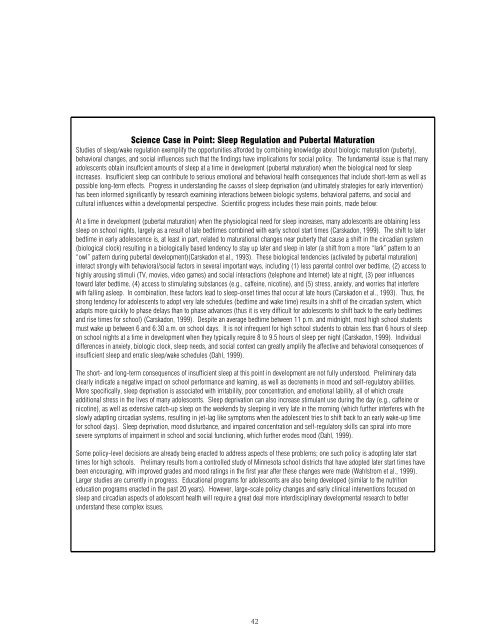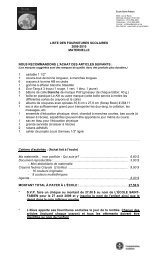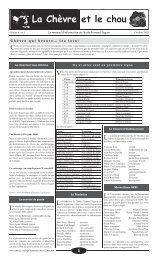Research on Child and Adolescent Mental Health
Research on Child and Adolescent Mental Health
Research on Child and Adolescent Mental Health
Create successful ePaper yourself
Turn your PDF publications into a flip-book with our unique Google optimized e-Paper software.
Science Case in Point: Sleep Regulati<strong>on</strong> <strong>and</strong> Pubertal Maturati<strong>on</strong><br />
Studies of sleep/wake regulati<strong>on</strong> exemplify the opportunities afforded by combining knowledge about biologic maturati<strong>on</strong> (puberty),<br />
behavioral changes, <strong>and</strong> social influences such that the findings have implicati<strong>on</strong>s for social policy. The fundamental issue is that many<br />
adolescents obtain insuffcient amounts of sleep at a time in development (pubertal maturati<strong>on</strong>) when the biological need for sleep<br />
increases. Insufficient sleep can c<strong>on</strong>tribute to serious emoti<strong>on</strong>al <strong>and</strong> behavioral health c<strong>on</strong>sequences that include short-term as well as<br />
possible l<strong>on</strong>g-term effects. Progress in underst<strong>and</strong>ing the causes of sleep deprivati<strong>on</strong> (<strong>and</strong> ultimately strategies for early interventi<strong>on</strong>)<br />
has been informed significantly by research examining interacti<strong>on</strong>s between biologic systems, behavioral patterns, <strong>and</strong> social <strong>and</strong><br />
cultural influences within a developmental perspective. Scientific progress includes these main points, made below:<br />
At a time in development (pubertal maturati<strong>on</strong>) when the physiological need for sleep increases, many adolescents are obtaining less<br />
sleep <strong>on</strong> school nights, largely as a result of late bedtimes combined with early school start times (Carskad<strong>on</strong>, 1999). The shift to later<br />
bedtime in early adolescence is, at least in part, related to maturati<strong>on</strong>al changes near puberty that cause a shift in the circadian system<br />
(biological clock) resulting in a biologically based tendency to stay up later <strong>and</strong> sleep in later (a shift from a more “lark” pattern to an<br />
“owl” pattern during pubertal development)(Carskad<strong>on</strong> et al., 1993). These biological tendencies (activated by pubertal maturati<strong>on</strong>)<br />
interact str<strong>on</strong>gly with behavioral/social factors in several important ways, including (1) less parental c<strong>on</strong>trol over bedtime, (2) access to<br />
highly arousing stimuli (TV, movies, video games) <strong>and</strong> social interacti<strong>on</strong>s (teleph<strong>on</strong>e <strong>and</strong> Internet) late at night, (3) peer influences<br />
toward later bedtime, (4) access to stimulating substances (e.g., caffeine, nicotine), <strong>and</strong> (5) stress, anxiety, <strong>and</strong> worries that interfere<br />
with falling asleep. In combinati<strong>on</strong>, these factors lead to sleep-<strong>on</strong>set times that occur at late hours (Carskad<strong>on</strong> et al., 1993). Thus, the<br />
str<strong>on</strong>g tendency for adolescents to adopt very late schedules (bedtime <strong>and</strong> wake time) results in a shift of the circadian system, which<br />
adapts more quickly to phase delays than to phase advances (thus it is very difficult for adolescents to shift back to the early bedtimes<br />
<strong>and</strong> rise times for school) (Carskad<strong>on</strong>, 1999). Despite an average bedtime between 11 p.m. <strong>and</strong> midnight, most high school students<br />
must wake up between 6 <strong>and</strong> 6:30 a.m. <strong>on</strong> school days. It is not infrequent for high school students to obtain less than 6 hours of sleep<br />
<strong>on</strong> school nights at a time in development when they typically require 8 to 9.5 hours of sleep per night (Carskad<strong>on</strong>, 1999). Individual<br />
differences in anxiety, biologic clock, sleep needs, <strong>and</strong> social c<strong>on</strong>text can greatly amplify the affective <strong>and</strong> behavioral c<strong>on</strong>sequences of<br />
insufficient sleep <strong>and</strong> erratic sleep/wake schedules (Dahl, 1999).<br />
The short- <strong>and</strong> l<strong>on</strong>g-term c<strong>on</strong>sequences of insufficient sleep at this point in development are not fully understood. Preliminary data<br />
clearly indicate a negative impact <strong>on</strong> school performance <strong>and</strong> learning, as well as decrements in mood <strong>and</strong> self-regulatory abilities.<br />
More specifically, sleep deprivati<strong>on</strong> is associated with irritability, poor c<strong>on</strong>centrati<strong>on</strong>, <strong>and</strong> emoti<strong>on</strong>al lability, all of which create<br />
additi<strong>on</strong>al stress in the lives of many adolescents. Sleep deprivati<strong>on</strong> can also increase stimulant use during the day (e.g., caffeine or<br />
nicotine), as well as extensive catch-up sleep <strong>on</strong> the weekends by sleeping in very late in the morning (which further interferes with the<br />
slowly adapting circadian systems, resulting in jet-lag like symptoms when the adolescent tries to shift back to an early wake-up time<br />
for school days). Sleep deprivati<strong>on</strong>, mood disturbance, <strong>and</strong> impaired c<strong>on</strong>centrati<strong>on</strong> <strong>and</strong> self-regulatory skills can spiral into more<br />
severe symptoms of impairment in school <strong>and</strong> social functi<strong>on</strong>ing, which further erodes mood (Dahl, 1999).<br />
Some policy-level decisi<strong>on</strong>s are already being enacted to address aspects of these problems; <strong>on</strong>e such policy is adopting later start<br />
times for high schools. Prelimary results from a c<strong>on</strong>trolled study of Minnesota school districts that have adopted later start times have<br />
been encouraging, with improved grades <strong>and</strong> mood ratings in the first year after these changes were made (Wahlstrom et al., 1999).<br />
Larger studies are currently in progress. Educati<strong>on</strong>al programs for adolescents are also being developed (similar to the nutriti<strong>on</strong><br />
educati<strong>on</strong> programs enacted in the past 20 years). However, large-scale policy changes <strong>and</strong> early clinical interventi<strong>on</strong>s focused <strong>on</strong><br />
sleep <strong>and</strong> circadian aspects of adolescent health will require a great deal more interdisciplinary developmental research to better<br />
underst<strong>and</strong> these complex issues.<br />
42

















